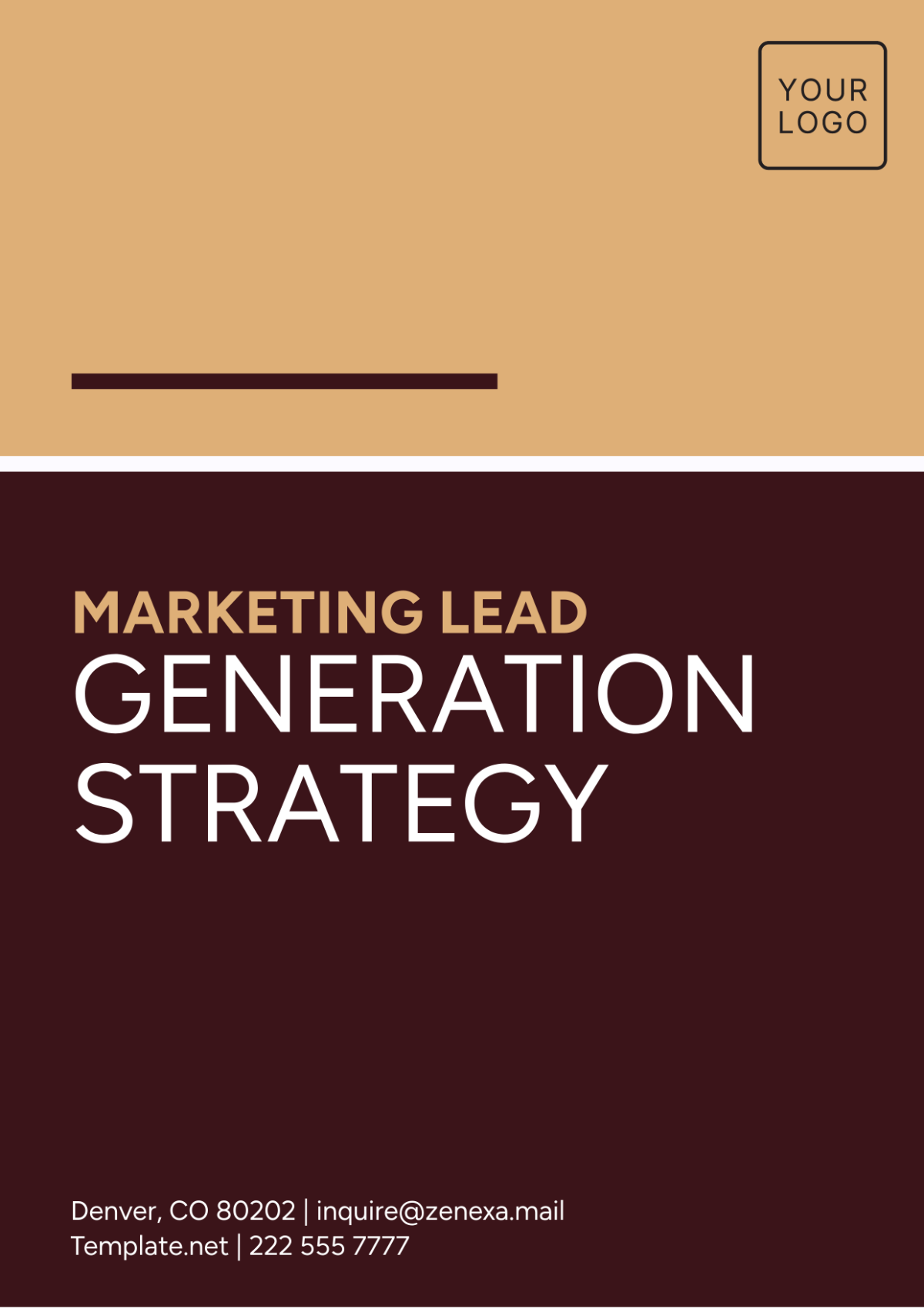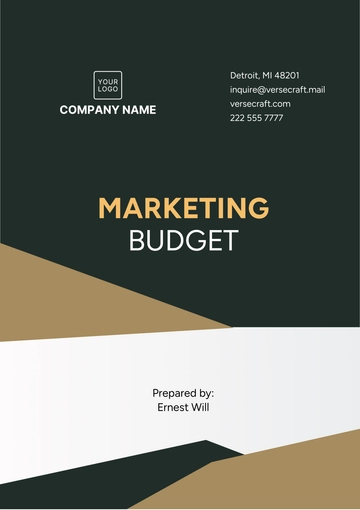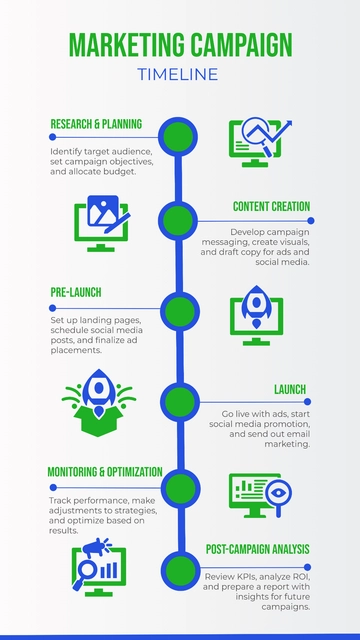Free Marketing Lead Generation Strategy

I. Executive Summary
This Marketing Lead Generation Strategy Plan outlines a comprehensive approach to attracting and converting potential customers into leads for [Your Company Name]. The plan details various tactics and methodologies to effectively generate leads, nurture them through the sales funnel, and ultimately drive growth and success for the company. By implementing these strategies, [Your Company Name] aims to increase lead acquisition, improve conversion rates, and enhance overall marketing effectiveness.
Objectives
Clearly defined objectives guide the lead generation strategy and provide measurable targets for assessing its success. Setting specific, actionable goals is essential for aligning efforts and resources effectively.
Increase Lead Volume: Aim to boost the number of leads generated by [30%] over the next year. This involves enhancing current lead generation methods and exploring new channels to reach a broader audience.
Improve Lead Quality: Focus on increasing the quality of leads by [25%], ensuring that they are more likely to convert into paying customers. This requires refining targeting criteria and lead qualification processes.
Enhance Lead Conversion Rate: Achieve a [20%] improvement in lead conversion rates by optimizing follow-up processes and nurturing strategies. Effective lead nurturing and engagement are key to converting prospects into clients.
Increase Brand Awareness: Enhance brand visibility by [40%] through lead generation activities. Increased brand awareness supports overall marketing efforts and attracts more potential leads.
II. Target Audience
Identifying and understanding the target audience is crucial for tailoring lead generation efforts to attract the right prospects. This section defines the key characteristics and needs of the ideal leads.
Demographics: Focus on individuals aged [25-45], predominantly professionals and decision-makers within their organizations. This demographic is more likely to be interested in [Your Company Name]'s products and services.
Industry: Target industries such as technology, finance, and healthcare where [Your Company Name] has a strong presence and expertise. These industries align with the company’s offerings and have high lead potential.
Job Titles: Aim at decision-makers including Chief Marketing Officers, Sales Directors, and Business Development Managers. These roles are pivotal in the purchasing process and are likely to influence buying decisions.
Pain Points: Address common challenges such as inefficient lead management, lack of data insights, and poor conversion rates. Tailor messaging to demonstrate how [Your Company Name]'s solutions can alleviate these issues.
III. Lead Generation Tactics
Implementing a diverse set of tactics ensures a comprehensive approach to lead generation, leveraging various channels and methods to maximize reach and effectiveness.
Content Marketing: Create and distribute valuable content such as blogs, whitepapers, and eBooks to attract and engage potential leads. Content marketing builds authority and attracts individuals interested in [Your Company Name]'s expertise.
Email Marketing: Develop targeted email campaigns to nurture leads and maintain engagement. Segment email lists to deliver personalized content that addresses specific interests and needs.
Social Media Marketing: Utilize platforms like LinkedIn, Twitter, and Facebook to reach and engage with potential leads. Share industry insights, company updates, and promotional content to drive interest and interactions.
Paid Advertising: Invest in targeted online ads, including PPC and display advertising, to capture the attention of potential leads. Use data-driven strategies to optimize ad placements and maximize ROI.
Webinars and Events: Host webinars and industry events to showcase expertise and generate leads. Provide valuable insights and interactive experiences to attract and engage potential prospects.
Referral Programs: Develop and promote referral programs to encourage existing clients and partners to refer new leads. Offer incentives to increase participation and expand the lead generation network.
IV. Lead Nurturing
Effective lead nurturing is essential for converting prospects into customers. This section outlines strategies for maintaining engagement and guiding leads through the sales funnel.
Automated Email Sequences: Implement automated email sequences to provide timely follow-ups and relevant content based on lead interactions. Automation helps streamline communication and keeps leads engaged.
Personalized Outreach: Tailor outreach efforts to individual leads based on their behavior, interests, and engagement history. Personalized communication enhances relevance and increases the likelihood of conversion.
Lead Scoring: Use lead scoring models to prioritize leads based on their likelihood to convert. Assign scores based on criteria such as engagement level, demographics, and behavior to focus resources on high-potential leads.
Retargeting: Employ retargeting strategies to re-engage leads who have previously interacted with [Your Company Name]. Display targeted ads and content to bring leads back into the conversion process.
V. Metrics and Evaluation
Measuring and evaluating the effectiveness of lead generation efforts is crucial for assessing performance and identifying areas for improvement. This section outlines key metrics and evaluation methods.
Key Performance Indicators (KPIs): Track KPIs such as lead volume, lead quality, conversion rate, and cost per lead to measure the success of lead generation activities. Regularly review these metrics to gauge performance and make data-driven decisions.
Campaign Analysis: Conduct in-depth analysis of lead generation campaigns to assess their effectiveness and ROI. Identify successful strategies and areas needing improvement to optimize future efforts.
Reporting: Generate regular reports on lead generation performance, providing insights into progress toward objectives and overall success. Share these reports with relevant stakeholders to inform strategic decisions.
VI. Budget and Resources
Allocating an appropriate budget and resources is essential for executing the lead generation strategy effectively. This section details the financial and resource requirements to support the planned activities.
Expense Category | Amount |
|---|---|
Content Creation | $15,000 |
Email Marketing | $10,000 |
Social Media Ads | $20,000 |
Paid Advertising | $25,000 |
Webinars and Events | $12,000 |
Referral Programs | $8,000 |
Total | $90,000 |
The budget allocates funds to various lead generation activities, ensuring that resources are distributed according to their importance and impact. The total budget of [$90,000] supports a comprehensive approach to attracting and nurturing leads, with investments in content, advertising, events, and referral programs.
VII. Implementation Timeline
An implementation timeline provides a structured schedule for executing the lead generation strategy. This section outlines key milestones and deadlines to ensure timely and effective execution.
Activity | Timeline | Responsible Party |
|---|---|---|
Content Creation | [Month Day, Year] - [Month Day, Year] | Marketing Team |
Email Marketing Setup | [Month Day, Year] - [Month Day, Year] | Email Specialist |
Social Media Campaign | [Month Day, Year] - [Month Day, Year] | Social Media Team |
Paid Advertising Launch | [Month Day, Year] - [Month Day, Year] | Ad Manager |
Webinar Hosting | [Month Day, Year] - [Month Day, Year] | Event Coordinator |
Referral Program Launch | [Month Day, Year] - [Month Day, Year] | Partner Relations |
The implementation timeline outlines key activities, start and end dates, and responsible parties, ensuring that each aspect of the lead generation strategy is executed according to schedule. This structured approach helps keep the team focused and organized, leading to successful execution of the strategy.
VIII. Next Steps
Outlining the next steps ensures that the strategy is put into action efficiently and effectively. This section provides actionable items to move forward with the lead generation plan.
Finalize Budget Allocation: Review and approve the budget to allocate resources accordingly.
Assign Responsibilities: Designate team members to oversee each lead generation tactic and ensure they have the necessary resources.
Develop Campaign Materials: Begin creating content, setting up email sequences, and designing ads as per the plan.
Launch and Monitor: Implement the lead generation activities, continuously monitor performance, and make adjustments as needed to optimize results.
The Marketing Lead Generation Strategy Plan provides a structured approach to attracting, nurturing, and converting leads for [Your Company Name]. By following this plan and adhering to the outlined tactics, objectives, and timelines, the company aims to achieve significant growth in lead acquisition and conversion, ultimately driving overall business success.
- 100% Customizable, free editor
- Access 1 Million+ Templates, photo’s & graphics
- Download or share as a template
- Click and replace photos, graphics, text, backgrounds
- Resize, crop, AI write & more
- Access advanced editor
Drive more leads with our Marketing Lead Generation Strategy Template from Template.net. Fully customizable and editable, this template offers a detailed layout for planning and executing effective lead generation campaigns. Easily personalize the strategy, editable in our Ai Editor Tool, to align with your sales goals and target audience.
You may also like
- Marketing Google Slide
- Marketing Letter
- Marketing Quotation
- Marketing Report
- Marketing Strategic Plan
- Marketing Plan
- Marketing Proposal
- Marketing Flyer
- Marketing Presentation
- Real Estate Marketing Plan
- Marketing Contract
- Marketing Agreement
- Marketing Resume
- Marketing Checklist
- Marketing Brochure
- Marketing Banner
- Marketing Schedule
- Marketing Vector
- Marketing Logo
- Marketing Chart
- Marketing Campaign Plan
- Marketing Budget
- Marketing Postcard
- Marketing Poster
- Marketing Facebook Post
- Marketing Instagram Post
- Marketing Newsletter
- Marketing Infographic





























